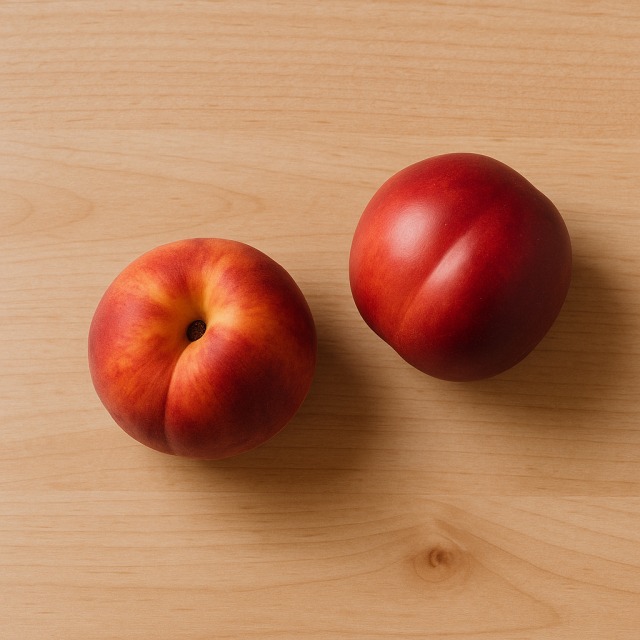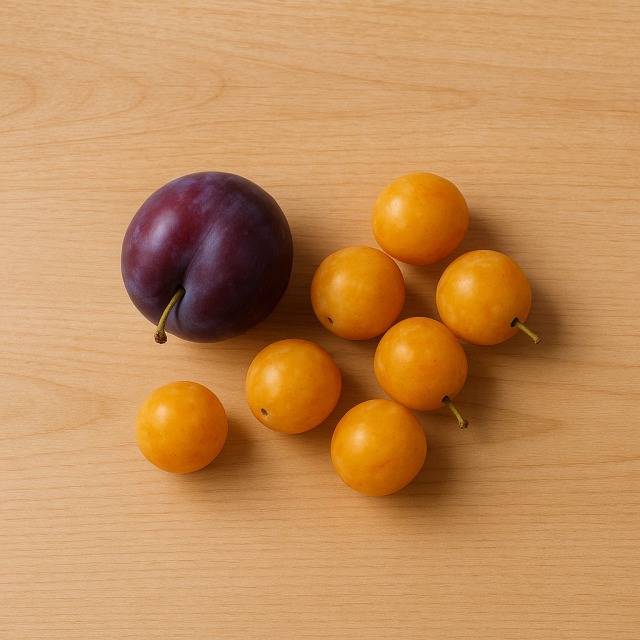Calorie Chart / Fruits / Nectarine
How Many Calories Are in Nectarine?
Calculation of the nutritional value & Recommended Dietary Intake of nectarine
For g and a calorie requirement of kcal
| Calories 38 kcal | Proteins 0.7 g | Lipids 0 g | Carbohydrates 8.8 g |
| 2% | 1% | 0% | 3% |
Health benefits of nectarine

Nectarine - 100g
Calories 54 kcal
Proteins 1 g
Lipids 0 g
Carbohydrates 12.5 g
Nectarine is a naturally sweet, low-calorie fruit: with only 54 calories per 100 g, it belongs to the low-calorie category, making it a smart choice for anyone counting calories throughout the day. Despite its light caloric footprint, it provides a satisfying mouthfeel thanks to soluble fiber that slows digestion and helps control calorie intake at the next meal.
This summer stone fruit supplies notable amounts of vitamin C, pro-vitamin A (beta-carotene), and potassium. Vitamin C contributes to normal immune function and enhances iron absorption, while beta-carotene supports skin health and vision. Potassium helps regulate fluid balance and blood pressure—an interesting benefit for active people who monitor calories and electrolytes after training sessions.
The red-orange pigments of nectarine contain polyphenols such as chlorogenic acid and anthocyanins with supposed antioxidant properties; several observational studies associate regular consumption of brightly colored fruit with better cardiovascular markers, but these benefits remain "supposed" because clinical evidence is still emerging. Finally, the thin edible skin concentrates much of the fiber: keeping the peel on saves preparation time, preserves micronutrients and, crucially, adds no extra calories.
Cultivated in China more than 2,000 years ago, the nectarine spread along the Silk Road to Persia and the Mediterranean basin. Today, France's Languedoc-Roussillon and Provence regions harvest juicy varieties from June to September; the short transport distance means fewer conservation treatments—another indirect plus when you watch calories and additives.
Tips for incorporating nectarine into a balanced diet
Because nectarines are low in calories yet rich in flavor, they perform well in balanced dishes where every calorie counts. For a refreshing breakfast, blend a diced nectarine with one plain yogurt, a handful of oat flakes, and a few crushed almonds: the proteins and good fats raise satiety without pushing calories too high.
At lunch, try a colorful salad: combine sliced nectarine, peppery arugula, shavings of parmigiano, and grilled chicken breast. Drizzle with a light vinaigrette; the dish supplies fewer calories than the usual mayonnaise-based salads while delivering contrasting textures.
For dessert, bake quartered nectarines with a teaspoon of honey and a sprinkle of pistachios. Ten minutes in the oven caramelizes natural sugars without adding many extra calories. The warm fruit pairs beautifully with a spoonful of chilled fromage blanc 0%, creating a gourmet yet calorie-conscious finale.
If you monitor daily calories strictly, remember that smoothies and juices concentrate carbohydrates: enjoy whole fruit instead of a large glass of nectarines blended with other high-sugar fruits like mango. Whole pieces slow down the glycemic response and make it easier to keep calories under control.
Frequently Asked Questions
- How many calories are in a nectarine?
- There are 54 kcal per 100 g.
- Is nectarine good for weight-loss diets?
- Yes, its 54 calories per 100 g, high water content, and fiber make it a satiating snack that helps keep daily calories in check.
- Do nectarine calories change if I peel the fruit?
- Peeling removes only the thin skin, so the difference in calories is negligible; however, you lose some fiber and antioxidants found in the peel.
- How do nectarine calories compare with peach calories?
- The two fruits are very close: peach averages about 50 kcal per 100 g, so choosing one or the other has little impact on total calories.
- Are nectarines high in sugar?
- They contain around 12.5 g of natural sugars per 100 g—moderate for fruit—and still provide fewer calories than processed snacks of similar sweetness.
- Can athletes eat nectarines after training?
- Absolutely. The natural sugars help replenish glycogen without excessive calories, while potassium supports electrolyte balance.
- What is the best way to store nectarines to preserve nutrients and avoid wasted calories?
- Keep firm nectarines at room temperature until slightly soft, then refrigerate and consume within three days. Chilling too early can dull flavor, tempting you to add sugar and hidden calories.
Similar foods
Information provided by Calorie Menu may contain inaccuracies or errors. It cannot, under any circumstances, substitute medical advice or medication.










